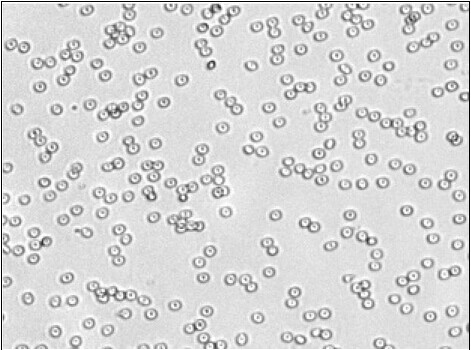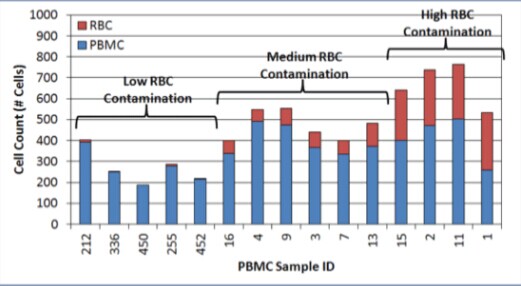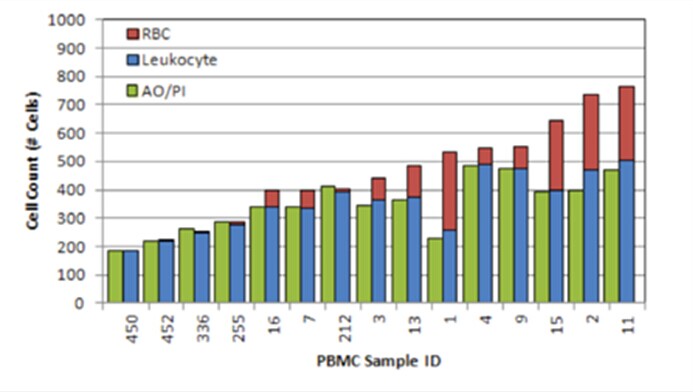Accurate counting and activity analysis of erythrocyte residual PBMC
Accurate counting and activity analysis of erythrocyte residual PBMC
First, the importance of PBMC accurate counting and activity analysis
PBMCs are usually isolated from whole blood or collected from a patient's cord blood. This process requires the isolation of PBMC from plasma, platelets, and red blood cells (RBC) using lymphocyte separation fluid. After separation, routine activity and concentration tests are required prior to cryopreservation or for various immunoassays to verify the quality of the sample.
One of the important problems is the contamination of red blood cells in PBMC cell separation. The contamination of red blood cells in PBMC samples leads to errors in measurement concentration and activity. This requires further experiments to analyze these cells. To solve this problem, it can be dissolved by RBC. To eliminate the problems caused by potential RBC pollution.
Second, the method of eliminating the counting error caused by red blood cells
1. Identification of fresh human PBMC sample residual RBC
Fifteen isolated fresh white blood cell samples were counted using a Cellometer Vision cell counter bright field image. The unique optical system visualized the biconcave of the red blood cells, so the PBMC and RBC were visualized and then the images were counted. Therefore, the PBMC and RBC can be visually recognized and then counted according to the image.
The figure below shows a PBMC sample with a bright field count, red circles with double concave red blood cells, and blue circles with PBMC


VISION CBA focusing, bright cell double concave structure bright field image Fluorescent dye stained PBMC confirmed, red arrow is biconcave red blood cells, green arrow is PBMC


Red circle circled red cells, blue circle circled PBMC
The pollution degree of RBC is calculated by the formula: pollution rate%=RBC count/total count×100%
The results showed that 4 samples were highly contaminated (more than 30%), 6 samples were moderately contaminated (between 10% and 30%), and 4 samples were low-lightly polluted (less than 10%).
2, AO / PI double dye live / dead cells for automatic counting
AO and PI are fluorescent nucleic acid dyes that detect the activity of cells. AO is a cell membrane permeable dye that stains total cells and emits green fluorescence. PI does not have cell membrane permeability, stains cells, and emits orange/red fluorescence. When dead cells contain both AO and PI, fluorescence resonance energy transfer occurs, and the fluorescence of AO divergence is absorbed by PI. Therefore, only living cells emit green fluorescence. In addition, mature platelets and red blood cells are non-nuclear and cannot be stained with fluorescent dyes and are completely excluded. 20 ul of the AO/PI mixture and 20 ul of the leukocyte sample were mixed in a ratio of 1:1, and the PBMC concentration was counted by a Cellometer cell counter.
3. Detection of PBMC cell viability by AO/PI

Sample A: Add AO/PI and then automatically count directly through the Cellometer Dual Fluorescence Cell Counter
Sample B: 3% acetic acid lysed red blood cells, then trypan blue staining, counting.
Comparing the two methods, the results show that the AO/PI double staining method can perform total PBMC counting and viability analysis without cleavage of RBC.
Counting 15 PBMC samples was performed using two methods of manual counting of blood cell counting plates and automatic counting of AO/PI double dyeing. Among them, the manual counting operator is an experienced counting expert who can distinguish red blood cells and PBMC with rich experience and constantly fine-tuning the focal length of the microscope.

As shown in the figure, the manual counting method is a blue column, and the AO/PI double-dyeing automatic counting method is a green column. The AO/PI double staining method is not affected by high RBC contamination and can accurately count PBMC. Manual counting requires an experienced operator to judge red blood cells and PBMC one by one. This result shows that the AO/PI double staining automatic counting is consistent with the results of manual counting of PBMC by experienced operators.
At the same time, the results of the separation in 15 samples vary greatly, and the difference in RBC contamination of red blood cells after separation in different people, especially different patients.
Third, the conclusion
RBC contamination greatly affects the accuracy and activity of PBMC samples. The degree of RBC contamination varies from patient to patient. The standard PBMC treatment protocol cannot distinguish. Only AOPI dual fluorescence automatic cell counters can be fast, efficient and accurate. PBMC counting and viability analysis are helpful for immunological research.
For details, please consult:
Daktronics Biotech Co., Ltd.
Organic hemp hearts are hemp seeds without the shell. It is a high-quality hulled seed with the fewest green husks. Organic hemp hearts, as one of the superfoods, is the new star in the international health food market recently. As a highly digestible source of plant-based protein, raw hemp hearts are great for athletes, vegans/vegetarians. Hemp seeds are a complete protein containing all 9 essential amino acids, which are required for our bodies to build protein and must be obtained through food.
Hemp Hearts,Organic Hemp Hearts,Organic Hulled Hemp Seed,Hemp Seed Hearts
Organicway (xi'an) Food Ingredients Inc. , https://www.organicwayinc.com